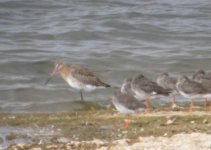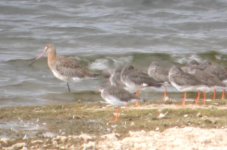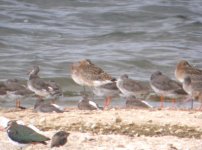-
Welcome to BirdForum, the internet's largest birding community with thousands of members from all over the world. The forums are dedicated to wild birds, birding, binoculars and equipment and all that goes with it.
Please register for an account to take part in the discussions in the forum, post your pictures in the gallery and more.
You are using an out of date browser. It may not display this or other websites correctly.
You should upgrade or use an alternative browser.
You should upgrade or use an alternative browser.
Check a bird id please (1 Viewer)
- Thread starter christineredgate
- Start date
More options
Who Replied?christineredgate
Winner of the Copeland Wildlife Photographer of th
Hi there,
I think its an adult. I think that the colour of the upper neck is too chestnutty for a juvenile. They have a lighter rufous wash which extends all the way down from under the chin onto the belly and flanks. The bird in your picture seems also to be showing quite a lot of grey on the coverts which, again, I think is indicative of an adult bird.
I could be wrong as I'm no expert but I just happen to have been struggling with this problem over the past week or so after watching a number of groups of this species passing through a local wet patch that I watch. I have been looking through various ID books just before I came online.
regards
Gordon
I think its an adult. I think that the colour of the upper neck is too chestnutty for a juvenile. They have a lighter rufous wash which extends all the way down from under the chin onto the belly and flanks. The bird in your picture seems also to be showing quite a lot of grey on the coverts which, again, I think is indicative of an adult bird.
I could be wrong as I'm no expert but I just happen to have been struggling with this problem over the past week or so after watching a number of groups of this species passing through a local wet patch that I watch. I have been looking through various ID books just before I came online.
regards
Gordon
christineredgate
Winner of the Copeland Wildlife Photographer of th
Gordon,thanks i was getting worried as i could see that people had viewed the pic,but no one had replied,but it is definitely a black tailed godwit is it.I think i have another pic of three together with their side feathers on view,I'll have a look.I have put one in the gallery but put it in Birds as opposed tom digiscoping.
Thanks,Christine.
Thanks,Christine.
Michael Frankis
conehead
I'd agree with adult Blackwit. Juveniles are more uniformly buffy all over and more 'cleanly' scalloped on the mantle & coverts.
Michael
Michael
christineredgate
Winner of the Copeland Wildlife Photographer of th
Thanks,Michael,I was hoping that either yourself or Stephen Dunstan would take a look.I won.t bother with the other pic now,
Thanks again,Christine.
Thanks again,Christine.
christineredgate
Winner of the Copeland Wildlife Photographer of th
Are you sure Spud,I did give it a highlight in photo shop
Christine
Christine
christineredgate
Winner of the Copeland Wildlife Photographer of th
Key features making it a juv are the consistently fresh plumage with all scapulars showing even dark centres (adults have a variable number of dark patterned scaps which appear patchily distributed and have bold pale internal bars, never look evenly spotted like this bird), wing coverts look fresh with neat pale fringes except for the innermost greater and median coverts which have dark subterminal marks, tertials a similar pattern to the inermost coverts only pattern a little more extensive. On adult the coverts and tertials are either winter patterned (plain grey) or a few show a bold summer pattern of cinnamon and black bars but these are irregularly distributed.
Any adult that still had so much rufous on the neck would still show some barring on the belly.
100% sure
Spud
Any adult that still had so much rufous on the neck would still show some barring on the belly.
100% sure
Spud
Stephen Dunstan
Registered User
Christine,
My ears were burning!
Was this at Hodbarrow? I dropped in there a couple of weeks back and there were half a dozen blackwits.
Regards,
Stephen.
My ears were burning!
Was this at Hodbarrow? I dropped in there a couple of weeks back and there were half a dozen blackwits.
Regards,
Stephen.
christineredgate
Winner of the Copeland Wildlife Photographer of th
Yes Stephen it was this afternoon,do you think it is a juvenile?.I must say this thread is much more interesting than the chat room where i dropped in a couple of mins ago.Anyway it looks as though my bird ID skills are picking up!!,
Christine.
Stephen next time you come over to hodbarrow let me know,i could learn a lot from your expertise.
Christine.
Christine.
Stephen next time you come over to hodbarrow let me know,i could learn a lot from your expertise.
Christine.
Michael Frankis
conehead
logos said:Key features making it a juv are the consistently fresh plumage with all scapulars showing even dark centres (adults have a variable number of dark patterned scaps which appear patchily distributed and have bold pale internal bars, never look evenly spotted like this bird), wing coverts look fresh with neat pale fringes except for the innermost greater and median coverts which have dark subterminal marks, tertials a similar pattern to the inermost coverts only pattern a little more extensive. On adult the coverts and tertials are either winter patterned (plain grey) or a few show a bold summer pattern of cinnamon and black bars but these are irregularly distributed.
Any adult that still had so much rufous on the neck would still show some barring on the belly.
Hi Spud,
Accepted I was wrong in saying adult, but that first bird to me didn't look at all consistently fresh or evenly spotted - looks to me as though there's several mantle feathers and one or two tertials & greater coverts moulted out and missing, and almost completely plain grey median & lesser coverts with hardly any fringing. A lot less neat & tidy than the right hand bird in the 3rd photo, which is an obvious juvenile. Also wouldn't a juv usually show less contrast between the whitish face and orange-buff neck? That's what made me think adult.
Michael
christineredgate
Winner of the Copeland Wildlife Photographer of th
So does one deduct from this discussion that it is a juvenile Godwit.It is all very technical,and far beyond me,but thankyou all for your comments,but Michael,please could you please think more kindly towards "moggies"
Christine,
Christine,
christineredgate
Winner of the Copeland Wildlife Photographer of th
Thanks,Midas,i looked up in my bird book when I came home and also on my bird online books,but was not really sure and in actual fact was making a guess that it was a Juvenile.Of course it is possible that adults were there with the young.
Christine.
Christine.
Stephen Dunstan
Registered User
Christine,
To answer your question to me I would go for an Icelandic race juv., bear in mind several hundred and even thousands will pass Hodbarrow en route to winter down here on the Ribble.
Only the weekend before last I got into a discussion about this regarding a bird at Pilling Marsh, which I immediately called as a juv and the person with me queried. So it isn't that straightforward.
Regards,
Stephen.
To answer your question to me I would go for an Icelandic race juv., bear in mind several hundred and even thousands will pass Hodbarrow en route to winter down here on the Ribble.
Only the weekend before last I got into a discussion about this regarding a bird at Pilling Marsh, which I immediately called as a juv and the person with me queried. So it isn't that straightforward.
Regards,
Stephen.
By mid-September adults are already in winter plumage or are very well advanced in post breeding moult. They therefore either look uniformly greyish or mostly plain greyish with a few scruffy remnants of summer plumage. Juveniles are much fresher and neater looking and few show any extensive plain grey first-winter mantle and scaps much before October. Ageing becomes difficult after December when the characteristically patterned juvenile upperparts have been replaced and any retained juvenile feathers have worn and faded and lost their pristine and delicately patterned appearance.
Only Icelandic race juvs show such rich orange tones on the underparts and therefore superficially resemble breeding adults, juveniles of other races have duller buff necks etc...
Anything that doesn't look plain grey or scruffy in autumn is a juv.
Spud
Only Icelandic race juvs show such rich orange tones on the underparts and therefore superficially resemble breeding adults, juveniles of other races have duller buff necks etc...
Anything that doesn't look plain grey or scruffy in autumn is a juv.
Spud
Hi all,
I too was thinking juv.Black-tailed Godwit,and was surprised when Michael said otherwise,but seeing as how it's an Icelandic bird then everything makes sense:we get Icelandic birds almost exclusively here,and thus the bird just looked like an "ordinary" juv.to me!
Harry H
I too was thinking juv.Black-tailed Godwit,and was surprised when Michael said otherwise,but seeing as how it's an Icelandic bird then everything makes sense:we get Icelandic birds almost exclusively here,and thus the bird just looked like an "ordinary" juv.to me!
Harry H
Michael Frankis
conehead
Yeah, the ones I see over here are nearly all European race, the Icelandic ones are a lot scarcer, odd ones mainly on spring passage. They obviously stick pretty closely to the west coast.
And I still plead that this bird (in the first photo) looks scruffy, not as neat as I'd have expected a juvenile to be. Guess it has already started its moult into first winter.
Michael
And I still plead that this bird (in the first photo) looks scruffy, not as neat as I'd have expected a juvenile to be. Guess it has already started its moult into first winter.
Michael
Users who are viewing this thread
Total: 2 (members: 0, guests: 2)







